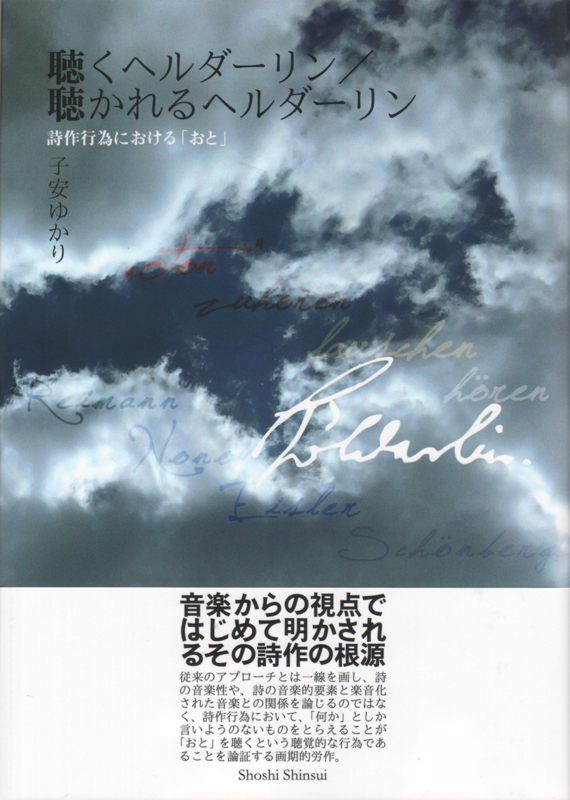
Title
Kiku Hölderlin / Kikareru Hölderlin (Hölderlin listens to/listened to – “tone” in composing poetry)
Size
288 pages, A5 format, hardcover
Language
Japanese
Released
March, 2019
ISBN
978-4-906917-89-1
Published by
Shoshi SHINSUI
Book Info
See Book Availability at Library
Japanese Page
Johann Christian Friedrich Hölderlin (1770–1843) is a poet who has been reevaluated since the 20th century. Today, he is known to rank together with Goethe, continuing to captivate not only literary scholars but also philosophers and artists, among others. The focus of this book is on 20th century composers. Although hardly any of Hölderlin’s poetry was set to music in the 19th century, well over a thousand such musical works have been produced since the 20th century. The aim of this book is to unravel the secret of this unique “Hölderlin’s poetry × music” synergy effect.
Accordingly, I pose the following two questions: 1. What kind of act is the act of “setting to music (vertonen)”?; 2. What kind of act was Hölderlin’s composition of poetry?
How did Hölderlin sense that “something” before any contact with language, and put it into “words” through numerous processes? This book argues that Hölderlin’s composition of poetry—that is to say, his sensing “something” and putting it into “words”—is the act of listening to “tone.” When I refer to “tone” (「おと」) here, it is not in its more general sense of the word. This “tone” is not concrete, and is also different from the idea of tone as atmosphere or mood; it refers to an earlier stage than that, to something more fundamental. This book also analyzes how composers feel the “something” in the poems and make them into music in order to elucidate that the act of “setting to music (vertonen)” is the act of listening to a poem’s “tone” and making that “tone” into music. These are new perspectives not found in any previous research. That composers since the 20th century, wanting to listen to “tone,” have come across the poetry of Hölderlin, who also listened to “tone,” is itself an explanation of the “Hölderlin’s poetry × music” phenomenon.
Firstly, Chapter 1 provides an overview of the cultural sphere in which Hölderlin lived, and his musical activities. In Chapter 2, the original meaning of the word vertonen, which has come to be translated as “setting to music,” is clarified through historical investigation and analysis of the word. Then, in Chapter 3, Hölderlin’s understanding of poetry’s “tone,” that composers try to listen to, is deciphered from a reading of Hölderlin’s own abstruse papers on aesthetics, and it is shown that for Hölderlin the act of composing poetry was the act of listening to “tone.” Furthermore, Chapter 4 takes up the setting to music of Hölderlin’s poetry by Eisler, Schönberg, Nono, and Reimann (who were active in the 20th century music world) and, with reference to remarks of the composers themselves, provides specific analysis of how they listened to the “tone” of Hölderlin’s poetry.
As a final word, I suspect that the act of listening to “tone” is not limited to the discussion of Hölderlin or a few composers, but may be the key to unlock the secrets of all creative activity. It would therefore be my utmost pleasure if my efforts in this book were to be of support to everyone involved with creative activities.
(Written by: KOYASU Yukari / January 12, 2021)




 eBook
eBook